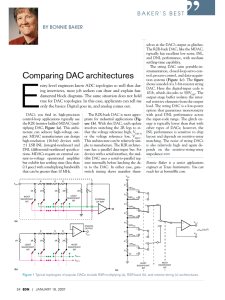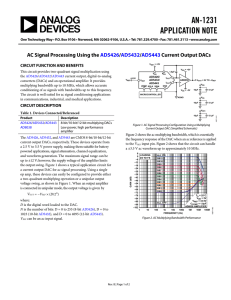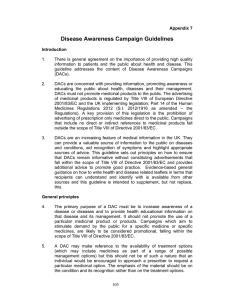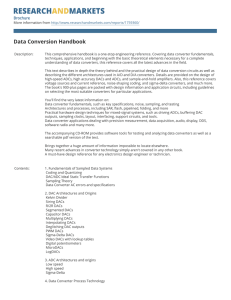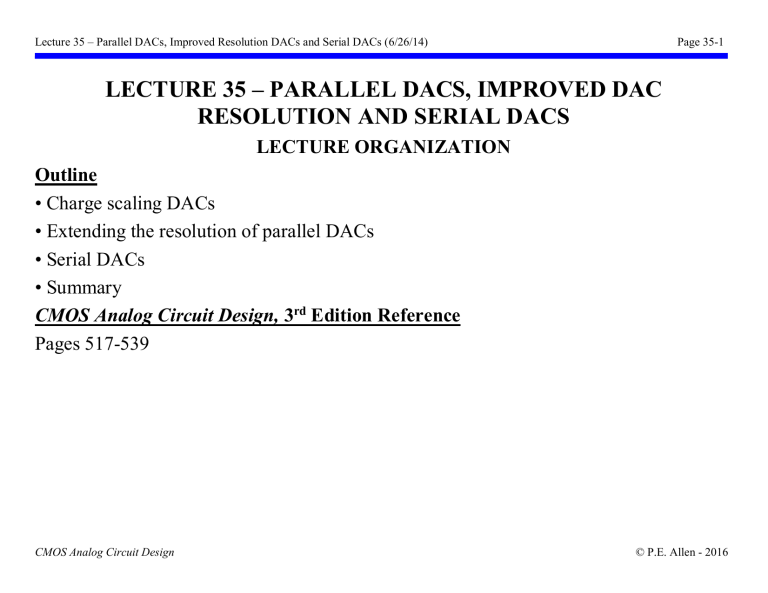
Lecture 35 – Parallel DACs, Improved Resolution DACs and Serial DACs (6/26/14) Page 35-1 LECTURE 35 – PARALLEL DACS, IMPROVED DAC RESOLUTION AND SERIAL DACS LECTURE ORGANIZATION Outline • Charge scaling DACs • Extending the resolution of parallel DACs • Serial DACs • Summary CMOS Analog Circuit Design, 3rd Edition Reference Pages 517-539 CMOS Analog Circuit Design © P.E. Allen - 2016 Lecture 35 – Parallel DACs, Improved Resolution DACs and Serial DACs (6/26/14) Page 35-2 CHARGE SCALING DIGITAL-ANALOG CONVERTERS General Charge Scaling Digital-Analog Converter Digital Input Word VREF Charge Scaling Network vOUT Fig. 10.2-9 C1 General principle is to capacitively attenuate the reference voltage. Capacitive attenuation is simply: + VREF Calculate as if the capacitors were resistors. For example, 1 C2 C1 Vout = 1 1 VREF = C1 + C2 VREF + C1 C2 CMOS Analog Circuit Design C2 Vout Fig. 10.2-9b © P.E. Allen - 2016 Lecture 35 – Parallel DACs, Improved Resolution DACs and Serial DACs (6/26/14) Page 35-3 Binary-Weighted, Charge Scaling DAC Circuit: Operation: 1.) All switches connected to ground during 1. 2.) Switch Si closes to VREF if bi = 1 or to ground if bi = 0. Equating the charge in the capacitors gives, b1C b2C bN-1C VREFCeq = VREF b0C + 2 + 22 + ... + N−1 = Ctot vOUT = 2C vOUT 2 which gives vOUT = [b02-1 + b12-2 + b22-3 + ... + bN-12-N]VREF Equivalent circuit of the binary-weighted, charge scaling DAC is: Attributes: Ceq. • Accurate + • Sensitive to parasitics vOUT VREF 2C - Ceq. • Not monotonic • Charge feedthrough occurs at turn on of switches CMOS Analog Circuit Design Fig. 10.2-11 © P.E. Allen - 2016 Lecture 35 – Parallel DACs, Improved Resolution DACs and Serial DACs (6/26/14) Page 35-4 Integral Nonlinearity of the Charge Scaling DAC Again, we use a worst case approach. Assume an n-bit charge scaling DAC with the MSB capacitor of C and the LSB capacitor of C/2n-1 and the capacitors have a tolerance of C/C. The ideal output when the i-th capacitor only is connected to VREF is VREF 2n 2n C/2i-1 vOUT (ideal) = 2C VREF = 2i 2n = 2i LSBs The maximum and minimum capacitance is Cmax = C + C and Cmin = C - C. Therefore, the actual worst case output for the i-th capacitor is VREF C·VREF 2n 2nC (C±C)/2i-1 vOUT(actual) = VREF = 2i ± 2iC = 2i ± 2iC LSBs 2C Now, the INL for the i-th bit is given as ±2nC 2n-iC INL(i) = vOUT(actual) - vOUT(ideal) = 2iC = C LSBs Typically, the worst case value of i occurs for i = 1. Therefore, the worst case INL is C INL = ± 2n-1 C LSBs CMOS Analog Circuit Design © P.E. Allen - 2016 Lecture 35 – Parallel DACs, Improved Resolution DACs and Serial DACs (6/26/14) Page 35-5 Differential Nonlinearity of the Charge Scaling DAC The worst case DNL for the binary weighted capacitor array is found when the MSB changes. The output voltage of the binary weighted capacitor array can be written as Ceq. vOUT = (2C-C ) + C VREF eq. eq. where Ceq are capacitors whose bits are 1 and (2C - Ceq) are capacitors whose bits are 0. The worst case DNL can be expressed as vstep(worst case) vOUT(1000....) - vOUT(0111....) LSBs DNL = 1 = 1 vstep(ideal) 1 LSB The worst case choice for the capacitors is to choose C1 larger by C and the remaining capacitors smaller by C giving, 1 1 1 1 C1=C+C, C2 = 2(C-C),...,Cn-1= n-2(C-C), Cn= n-1(C-C), and Cterm= n-1(C-C) 2 2 2 n Note that Ci + Cterm = C2+ C3+···+ Cn-1+ Cn+ Cterm = C-C i=2 CMOS Analog Circuit Design © P.E. Allen - 2016 Lecture 35 – Parallel DACs, Improved Resolution DACs and Serial DACs (6/26/14) Page 35-6 Differential Nonlinearity of the Charge Scaling DAC - Continued C+C C+C VREF = vOUT(1000...) = V 2C REF (C+C)+(C-C) C+C 2n C+C = 2C VREF n = 2n 2C LSBs 2 and 1 (C C) (C-C) (C-C) -Cterm 2n-1 VREF = vOUT(0111...) = VREF (C+ C)+(C C) (C+ C)+(C C) C-C C-C 2 2nC-C 2 2 = 2C 1 - 2nVREF = n 2C 1 - 2nVREF = 2n 2C 1 - 2n LSBs 2 vOUT(1000...) - vOUT(0111...) C+C C-C 2 C LSBs = 2n -2n 1- n-1 = (2n-1) -1 1 LSB C LSBs 2C 2C 2 Therefore, CMOS Analog Circuit Design DNL = (2n - 1) C C LSBs © P.E. Allen - 2016 Lecture 35 – Parallel DACs, Improved Resolution DACs and Serial DACs (6/26/14) Page 35-7 Example 35-1 - DNL and INL of a Binary Weighted Capacitor Array DAC If the tolerance of the capacitors in an 8-bit, binary weighted, charge scaling DAC are ±0.5%, find the worst case INL and DNL. Solution For the worst case INL, we get from above that INL = (27)(±0.005) = ±0.64 LSBs For the worst case DNL, we can write that DNL = (28-1)(±0.005) = ±1.275 LSBs CMOS Analog Circuit Design © P.E. Allen - 2016 Lecture 35 – Parallel DACs, Improved Resolution DACs and Serial DACs (6/26/14) Page 35-8 Example 35-2 - Influence of Capacitor Ratio Accuracy on Number of Bits Use the data shown to estimate the number of bits possible for a charge scaling DAC assuming a worst case approach for INL and that the worst conditions occur at the midscale (1 MSB). Solution Assuming an INL of ±0.5 LSB, we can write that C 1 1 C INL = ±2N-1 C ≤ ± 2 → C = N 2 Let us assume a unit capacitor of 50 µm by 50 µm and a relative accuracy of approximately ±0.1%. Solving for N in the above equation gives approximately 10 bits. However, the ±0.1% figure corresponds to ratios of 16:1 or 4 bits. In order to get a solution, we estimate the relative accuracy of capacitor ratios as C C ≈ 0.001 + 0.0001N Using this approximate relationship, a 9-bit digital-analog converter should be realizable. CMOS Analog Circuit Design © P.E. Allen - 2016 Lecture 35 – Parallel DACs, Improved Resolution DACs and Serial DACs (6/26/14) Page 35-9 Binary Weighted, Charge Amplifier DAC Attributes: • No floating nodes which implies insensitive to parasitics and fast • No terminating capacitor required • With the above configuration, charge feedthrough will be Verror -(COL/2CN)V • Can totally eliminate parasitics with parasitic-insensitive switched capacitor circuitry but not the charge feedthrough CMOS Analog Circuit Design © P.E. Allen - 2016 Lecture 35 – Parallel DACs, Improved Resolution DACs and Serial DACs (6/26/14) Page 35-10 EXTENDING THE RESOLUTION OF PARALLEL DIGITAL-ANALOG CONVERTERS Background Technique: N Divide the total resolution N into k smaller sub-DACs each with a resolution of k . Result: Smaller total area. More resolution because of reduced largest to smallest component spread. Approaches: • Combination of similarly scaled subDACs Divider approach (scale the analog output of the subDACs) Subranging approach (scale the reference voltage of the subDACs) • Combination of differently scaled subDACs CMOS Analog Circuit Design © P.E. Allen - 2016 Lecture 35 – Parallel DACs, Improved Resolution DACs and Serial DACs (6/26/14) Page 35-11 COMBINATION OF SIMILARLY SCALED SUBDACs Analog Scaling - Divider Approach VREF Example of combining a m-bit m-bit + m-MSB and k-bit subDAC to form a vOUT MSB S bits + DAC m+k-bit DAC. VREF k-LSB bits k-bit LSB DAC ¸ 2m Fig. 10.3-1 bm-1 bm+k-1 b0 b1 1 bm bm+1 VREF vOUT = 2 + 4 + ··· + m VREF + m 2 + 4 + ··· + k 2 2 2 bm-1 bm bm+1 bm+k-1 b0 b1 vOUT = 2 + 4 + ··· + m + m+1 + m+2 + ··· + m+k VREF 2 2 2 2 CMOS Analog Circuit Design © P.E. Allen - 2016 Lecture 35 – Parallel DACs, Improved Resolution DACs and Serial DACs (6/26/14) Page 35-12 Example 35-3 - Illustration of the Influence of the Scaling Factor Assume that m = 2 and k = 2 in Fig. 10.3-1 and find the transfer characteristic of this DAC if the scaling factor for the LSB DAC is 3/8 instead of 1/4. Assume that VREF = 1V. What is the ±INL and ±DNL for this DAC? Is this DAC monotonic or not? Solution The ideal DAC output is given as b0 b1 1b2 b3 b0 b1 b2 b3 vOUT = 2 + 4 + 4 2 + 4 = 2 + 4 + 8 + 16 . The actual DAC output can be written as b0 b1 3b2 3b3 16b0 8b1 6b2 3b3 vOUT(act.) = + + + = + + + 2 4 16 32 32 32 32 32 The results are tabulated in the following table for this example. CMOS Analog Circuit Design © P.E. Allen - 2016 Lecture 35 – Parallel DACs, Improved Resolution DACs and Serial DACs (6/26/14) Page 35-13 Example 35-3 - Continued Ideal and Actual Analog Output for the DAC in Ex. 35-3, Input vOUT(act.) Digital Word 0000 0/32 0001 3/32 0010 6/32 0011 9/32 0100 8/32 0101 11/32 0110 14/32 0111 17/32 1000 16/32 1001 19/32 1010 22/32 1011 25/32 1100 24/32 1101 27/32 1110 30/32 1111 33/32 CMOS Analog Circuit Design vOUT vOUT(act.) - vOUT 0/32 2/32 4/32 6/32 8/32 10/32 12/32 14/32 16/32 18/32 20/32 22/32 24/32 26/32 28/32 30/32 0/32 1/32 2/32 3/32 0/32 1/32 2/32 3/32 0/32 1/32 2/32 3/32 0/32 1/32 2/32 3/32 Change in vOUT(act) 2/32 1/32 1/32 1/32 -3/32 1/32 1/32 1/32 -3/32 1/32 1/32 1/32 -3/32 1/32 1/32 1/32 The table contains all the information we are seeking. An LSB for this example is 1/16 or 2/32. The fourth column gives the +INL as 1.5LSB and the -INL as 0LSB. The fifth column gives the +DNL as 0.5LSB and the -DNL as -1.5LSB. Because the -DNL is greater than -1LSB, this DAC is not monotonic. © P.E. Allen - 2016 Lecture 35 – Parallel DACs, Improved Resolution DACs and Serial DACs (6/26/14) Page 35-14 Reference Scaling - Subranging Approach Example of combining a m-bit and k-bit subDAC to form a m+k-bit DAC. VREF m-MSB bits m-bit MSB DAC + S + vOUT VREF/2m k-LSB bits k-bit LSB DAC Fig. 10.3-2 bm-1 bm+k-1VREF b0 b1 bm bm+1 vOUT = 2 + 4 + ··· + m VREF + 2 + 4 + ··· + 2 2k 2m bm-1 bm bm+1 bm+k-1 b0 b1 vOUT = + + ··· + m + m+1 + m+2 + ··· + m+k VREF 4 2 2 2 2 2 Accuracy considerations of this method are similar to the analog scaling approach. Advantage: There are no dynamic limitations associated with the scaling factor of 1/2m. CMOS Analog Circuit Design © P.E. Allen - 2016 Lecture 35 – Parallel DACs, Improved Resolution DACs and Serial DACs (6/26/14) Page 35-15 Current Scaling Dac Using Two SubDACs Implementation: b0 b1 b2 b3 1 b4 b5 b6 b7 + vOUT = RFI + + + + + + 2 4 8 16 16 2 4 8 16 CMOS Analog Circuit Design © P.E. Allen - 2016 Lecture 35 – Parallel DACs, Improved Resolution DACs and Serial DACs (6/26/14) Page 35-16 Charge Scaling DAC Using Two SubDACs Implementation: Design of the scaling capacitor, Cs: The series combination of Cs and the LSB array must terminate the MSB array or equal C/8. Therefore, we can write C 1 1 8 1 16 1 15 = or = = = 8 1 1 Cs C 2C 2C 2C 2C Cs + 2C CMOS Analog Circuit Design © P.E. Allen - 2016 Lecture 35 – Parallel DACs, Improved Resolution DACs and Serial DACs (6/26/14) Page 35-17 Equivalent Circuit of the Charge Scaling Dac Using Two SubDACs Simplified equivalent circuit: where the Thevenin equivalent voltage of the MSB array is 1 1/2 1/4 1/8 16 b0 b1 b2 b3 V1 = 15/8 b0 + 15/8 b1 + 15/8 b2 + 15/8 b3VREF = 15 2 + 4 + 8 + 16 VREF and the Thevenin equivalent voltage of the LSB array is 1/1 1/2 1/4 1/8 b4 b5 b6 b7 V2 = 2 b4 + 2 b5 + 2 b6 + 2 b7VREF = 2 + 4 + 8 + 16 VREF Combining the elements of the simplified equivalent circuit above gives 8 1 +15 15+15·15 2 2 15 16 vOUT= V1+ V2= V1+ V2= 15+15·15+16 15+15·15+16 1 +15 + 8 1 +15 + 8 2 2 15 2 2 15 15 1 7 bV V + V b b b b b b b b 1 2 i REF 0 1 2 3 4 5 6 7 16 16 vOUT = 2 + 4 + 8 + 16 + 32 + 64 + 128 + 256VREF = 2i+1 i=0 CMOS Analog Circuit Design © P.E. Allen - 2016 Lecture 35 – Parallel DACs, Improved Resolution DACs and Serial DACs (6/26/14) CMOS Analog Circuit Design Page 35-18 © P.E. Allen - 2016 Lecture 35 – Parallel DACs, Improved Resolution DACs and Serial DACs (6/26/14) Page 35-19 Charge Amplifier DAC Using Two Binary Weighted Charge Amplifier SubDACs Implementation: Attributes: • MSB subDAC is not dependent upon the accuracy of the scaling factor for the LSB subDAC. • Insensitive to parasitics, fast • Limited to op amp dynamics (GB) • No ICMR problems with the op amp CMOS Analog Circuit Design © P.E. Allen - 2016 Lecture 35 – Parallel DACs, Improved Resolution DACs and Serial DACs (6/26/14) Page 35-20 COMBINATION OF DIFFERENTLY SCALED SUBDACs Voltage Scaling MSB SubDAC And Charge Scaling LSB SubDAC Implementation: m-MSB bits v m-bit, MSB voltage scaling subDAC m-to-2m Decoder A R1 VREF R2 R 3 R2m-2 R2m-1 SF Ck = 2k-1C Bus A Sk,A R2m Sk,B m-to-2m Decoder B OUT Ck-1 = 2k-2C C1 =C Sk-1,A S2A S1A Sk-1,B S2B S1B Bus B SF C2 =2C C k-bit, LSB charge scaling subDAC Operation: m-MSB bits 1.) Switches SF and S1B through Sk,B discharge all capacitors. Fig. 10.3-7 2.) Decoders A and B connect Bus A and Bus B to the top and bottom, respectively, of the appropriate resistor as determined by the m-bits. 3.) The charge scaling subDAC divides the voltage across this resistor by capacitive division determined by the k-bits. Attributes: • MSB’s are monotonic but the accuracy is poor • Accuracy of LSBs is good CMOS Analog Circuit Design © P.E. Allen - 2016 Lecture 35 – Parallel DACs, Improved Resolution DACs and Serial DACs (6/26/14) Page 35-21 Voltage Scaling MSB SubDAC And Charge Scaling LSB SubDAC - Continued Equivalent circuit of the voltage scaling (MSB) and charge scaling (LSB) DAC: Ck = Bus A 2k-1C 2-mVREF Ck-1 = 2k-2C C2 =2C C1 =C Sk,A Sk-1,A S2A S1A Sk,B Sk,B S2B S1B vOUT Bus B where, Bus A Ceq. C V'REF 2-mVREF 2kC - Ceq. Bus B v'OUT vOUT V'REF Fig. 10.3-8 bm-2 bm-1 b0 b1 V’REF = VREF 21 + 22 + ··· + 2m-1 + 2m and VREF bm bm+1 bm+k bm+k-1 bm+1 bm+k bm+k-1 bm v’OUT = 2m 2 + 22 + ··· + 2k-1 + 2k = VREF 2m+1 + 2m+2 + ··· + 2m+k-1 + 2m+k Adding V’REF and v’OUT gives the DAC output voltage as bm-2 bm-1 bm bm+1 bm+k bm+k-1 b0 b1 vOUT = V’REF + v’OUT = VREF 1+ 2+···+ m-1+ m + m+1+ m+2+···+ m+k-1+ m+k 2 2 2 2 2 2 2 2 which is equivalent to an m+k bit DAC. CMOS Analog Circuit Design © P.E. Allen - 2016 Lecture 35 – Parallel DACs, Improved Resolution DACs and Serial DACs (6/26/14) Page 35-22 Charge Scaling MSB SubDAC and Voltage Scaling LSB SubDAC C1 = 2m C vOUT VREF C2 = 2m-1C S1,A S1,B S2,A S2,B Cm-1 =21C Cm =C Sm-2A Sm-1A Sm-2B Sm-1B m-bit, MSB charge scaling subDAC R1 Cm =C R2 kvk to2k Decoder R3 VREF R2k-2 R2k-1 Fig. 10.3-9A k-LSB bits k-bit, R2k LSB voltage scaling subDAC bm-2 bm-1 vk bm+k bm+k-1 b0 b1 bm bm+1 vOUT = 21+22+···+2m-1+ 2m VREF+2m where vk = 21 + 22 +···+ 2k-1 + 2k VREF bm-2 bm-1 bm bm+1 bm+k bm+k-1 b0 b1 vOUT =21 + 22 + ··· + 2m-1 + 2m + 2m+1 + 2m+2 + ··· + 2m+k-1 + 2m+k VREF Attributes: • MSBs have good accuracy • LSBs are monotonic, have poor accuracy - require trimming for good accuracy CMOS Analog Circuit Design © P.E. Allen - 2016 Lecture 35 – Parallel DACs, Improved Resolution DACs and Serial DACs (6/26/14) Page 35-23 Tradeoffs in SubDAC Selection to Enhance Linearity Performance Assume a m-bit MSB subDAC and a k-bit LSB subDAC. MSB Voltage Scaling SubDAC and LSB Charge Scaling SubDAC (n = m+k) INL and DNL of the m-bit MSB voltage-scaling subDAC: 2n R R ± R 2n ± R k INL(R) = 2m-1 m = 2n-1 LSBs and DNL(R) = = 2 LSBs R R 2m R 2 R INL and DNL of the k-bit LSB charge-scaling subDAC: C C k-1 k INL(C) = 2 C LSBs and DNL(C) = (2 -1) C LSBs Combining these relationships: C n-1 R k-1 INL = INL(R) + INL(C) = 2 + 2 R C LSBs k and R C DNL = DNL(R) + DNL(C) = 2 R + (2k-1) C LSBs MSB Charge Scaling SubDAC and LSB Voltage Scaling SubDAC C k-1 R n-1 INL = INL(R) + INL(C) = 2 R +2 C LSBs R C and DNL = DNL(R) + DNL(C) = R + (2n-1) C LSBs CMOS Analog Circuit Design © P.E. Allen - 2016 Lecture 35 – Parallel DACs, Improved Resolution DACs and Serial DACs (6/26/14) Page 35-24 Example 35-4 – DAC with Voltage Scaling for MBSs and Charge Scaling for LSBs Consider a 12-bit DAC that uses voltage scaling for the MSBs charge scaling for the LSBs. To minimize the capacitor element spread and the number of resistors, choose m = 5 and k = 7. Find the tolerances necessary for the resistors and capacitors to give an INL and DNL equal to or less than 2 LSB and 1 LSB, respectively. Solution Substituting n = 12 and k = 7 into the previous equations gives R 6 C R C 11 7 7 2=2 R +2 C and 1 = 2 R + (2 -1) C Solving these two equations simultaneously gives C C 24-2 C = 211 - 26 - 24 = 0.0071 C = 0.71% R R 28 - 26 -2 = 18 13 11 = 0.0008 = 0.075% R R 2 -2 -2 We see that the capacitor tolerance will be easy to meet but that the resistor tolerance will require resistor trimming to meet the 0.075% requirement. Because of the 2n-1 multiplying R/R in the relationship, we are stuck with approximately 0.075%. Therefore, choose m = 2 (which makes the 0.075% easier to achieve) and let k = 10 which gives R/R = 0.083% and C/C = 0.12%. CMOS Analog Circuit Design © P.E. Allen - 2016 Lecture 35 – Parallel DACs, Improved Resolution DACs and Serial DACs (6/26/14) Page 35-25 Example 35-5 - DAC with Charge Scaling for MBSs and Voltage Scaling for LSBs Consider a 12-bit DAC that uses charge scaling for the MSBs voltage scaling for the LSBs. To minimize the capacitor element spread and the number of resistors, choose m = 7 and k = 5. Find the tolerances necessary for the resistors and capacitors to give an INL and DNL equal to or less than 2 LSB and 1 LSB, respectively. Solution Substituting the values of this example into the relationships developed on a previous slide, we get R C R C 2 = 24 R + 211 C and 1 = R + (212-1) C Solving these two equations simultaneously gives C C R 3 R 24-2 = = 0.000221 = 0.0221% and = 0.0968 C 216-211-24 C R 25-1 R = 9.68% For this example, the resistor tolerance is easy to meet but the capacitor tolerance will be difficult. To achieve accurate capacitor tolerances, we should decrease the value of m and increase the value of k to achieve a smaller capacitor value spread and thereby enhance the tolerance of the capacitors. If we choose m = 4 and k = 8, the capacitor tolerance is 0.049% and the resistor tolerance becomes 0.79% which is still reasonable. The largest to smallest capacitor ratio is 8 rather than 64 which helps to meet the capacitor tolerance requirements. CMOS Analog Circuit Design © P.E. Allen - 2016 Lecture 35 – Parallel DACs, Improved Resolution DACs and Serial DACs (6/26/14) Page 35-26 Example 35-5 – Continued Based on the previous slide, we need to minimize the number of MSB bits as capacitors to enhance the accuracy. This puts pressure on the resistors. A good compromise is: MSB subdac: 2 bits capacitive scaling. LSB subdac: A 10 bit, R-2R ladder. With this design, the tolerances become, 2 = 29 R R + 211 C C and 1= R R + (212-1) C C giving, C C R C R 1-2-8 12-1) = =0.000243 =0.0243% and −(2 =0.00388 C 212-1-2-3 C R C R =0.388% Possible realization: CMOS Analog Circuit Design © P.E. Allen - 2016 Lecture 35 – Parallel DACs, Improved Resolution DACs and Serial DACs (6/26/14) Page 35-27 SERIAL DIGITAL-ANALOG CONVERTERS Serial DACs • Typically require one clock pulse to convert one bit • Types considered here are: Charge-redistribution Algorithmic Charge Redistribution DAC Implementation: S1 S2 VREF S3 C1 C2 S4 vC2 Fig. 10.4-1 Operation: Switch S1 is the redistribution switch that parallels C1 and C2 sharing their charge Switch S2 precharges C1 to VREF if the ith bit, bi, is a 1 Switch S3 discharges C1 to zero if the ith bit, bi, is a 0 Switch S4 is used at the beginning of the conversion process to initially discharge C2 Conversion always begins with the LSB bit and goes to the MSB bit. CMOS Analog Circuit Design © P.E. Allen - 2016 Lecture 35 – Parallel DACs, Improved Resolution DACs and Serial DACs (6/26/14) Page 35-28 CMOS Analog Circuit Design vC2/VREF vC1/VREF Example 35-6 - Operation of the Serial, Charge Redistribution DAC Assume that C1 = C2 and that 1 1 13/16 13/16 the digital word to be converted 3/4 3/4 is given as b0 = 1, b1 = 1, b2 = 0, 1/2 1/2 and b3 = 1. Follow through the 1/4 1/4 sequence of events that result in 0 0 0 1 2 3 4 5 6 7 8 0 1 2 3 4 5 6 7 8 Fig. 10.4-2 the conversion of this digital t/T t/T input word. Solution 1.) S4 closes setting vC2 = 0. 2.) b3 = 1, closes switch S2 causing vC1 = VREF. 3.) Switch S1 is closed causing vC1 = vC2 = 0.5VREF. 4.) b2 = 0, closes switch S3, causing vC1 = 0V. 5.) S1 closes, the voltage across both C1 and C2 is 0.25VREF. 6.) b1 = 1, closes switch S2 causing vC1 = VREF. 7.) S1 closes, the voltage across both C1 and C2 is (1+0.25)/2VREF = 0.625VREF. 8.) b0 = 1, closes switch S2 causing vC1 = VREF. 9.) S1 closes, the voltage across both C1 and C2 is (0.625+1)/2VREF = 0.8125VREF = (13/16)VREF. © P.E. Allen - 2016 Lecture 35 – Parallel DACs, Improved Resolution DACs and Serial DACs (6/26/14) Page 35-29 Pipeline DAC The pipeline DAC is simply an extension of the sub-DACs concept to the limit where the bits converted by each sub-DAC is 1. Implementation: Vout(z) = [b0z-1 + 2-1b1z-2 + ··· + 2-(N-2)bN-2z-(N-1) + bN-1z-N]VREF where bi is either ±1 if the ith bit is high or low. The z-1 blocks represent a delay of one clock period between the 1-bit sub-DACs. Attributes: • Takes N+1 clock cycles to convert the digital input to an analog output • However, a new analog output is converted every clock after the initial N+1 clocks CMOS Analog Circuit Design © P.E. Allen - 2016 Lecture 35 – Parallel DACs, Improved Resolution DACs and Serial DACs (6/26/14) Page 35-30 Algorithmic (Iterative) DAC Implementation: Closed form of the previous series expression is, biz-1VREF Vout(z) = 1 - 0.5z-1 Operation: Switch A is closed when the ith bit is 1 and switch B is closed when the ith bit is 0. Start with the LSB and work to the MSB. CMOS Analog Circuit Design © P.E. Allen - 2016 Lecture 35 – Parallel DACs, Improved Resolution DACs and Serial DACs (6/26/14) Page 35-31 Example 35-7 - Digital-Analog Conversion Using the Algorithmic Method Assume that the digital word to be converted is 11001 in the order of MSB to LSB. Find the converted output voltage and sketch a plot of vOUT/VREF as a function of t/T, vOUT/VREF where T is the period for one conversion. 2.0 Solution 19/16 1.) The conversion starts by zeroing the 1.0 output (not shown on Fig. 10.4-4). 2.) The LSB = 1, switch A is closed and VREF 3/8 0 t/T is summed with zero to give an output of 5 4 3 2 1 0 -1/2 +VREF. -1.0 3.) The next LSB = 0, switch B is closed and -5/4 vOUT = -VREF+0.5VREF = -0.5VREF. Fig. 10.4-5 4.) The next LSB = 0, switch B is closed and -2.0 vOUT = -VREF+0.5(-0.5VREF) = 1.25VREF. 5.) The next LSB = 1, switch A is closed and vOUT = VREF+0.5(-1.25VREF) = 0.375VREF. CMOS Analog Circuit Design © P.E. Allen - 2016 Lecture 35 – Parallel DACs, Improved Resolution DACs and Serial DACs (6/26/14) Page 35-32 6.) The MSB = 1, switch A is closed and vOUT = VREF + 0.5(0.375VREF) = 1.1875VREF = (19/16)VREF. (Note that because the actual VREF of this example if ±VREF or 2VREF, the analog value of the digital word 11001 is 19/32 times 2VREF or (19/16)VREF.) CMOS Analog Circuit Design © P.E. Allen - 2016 Lecture 35 – Parallel DACs, Improved Resolution DACs and Serial DACs (6/26/14) Page 35-33 SUMMARY • Voltage scaling DACs are monotonic, use equal resistors but are sensitive to capacitve parasitics • Charge scaling DACs are fast with good accuracy but have large element spread and are nonmonotonic • DAC resolution can be increased by combining several subDACs with smaller resolution • Methods of combining include scaling the output or the reference of the non-MSB subDACs • SubDACs can use similar or different scaling methods • Tradeoffs in the number of bits per subDAC and the type of subDAC allow minimization of the INL and DNL • Serial, charge redistribution DAC is simple and requires minimum area but is slow and requires complex external circuitry • Pipeline DAC has a latency of N+1 clock cycles but gives an analog output for each clock • Serial, algorithmic DAC is simple and requires minimum area but is slow and requires complex external circuitry CMOS Analog Circuit Design © P.E. Allen - 2016
